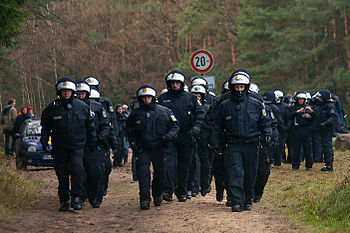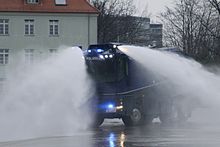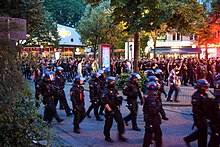This articleneeds additional citations forverification.(February 2013) |
TheBereitschaftspolizei(literally 'Readiness Police'/On-Call Police (Reserve); effectivelyriot police), abbreviatedBePo,are the support and rapid reaction units ofGermany's police forces. They are composed of detachments from theFederal Policeand theState Policeforces of Germany.




Federal Republic
editTheFederal Ministry of the Interiormaintains an office of theBereitschaftspolizeiin Berlin which monitors and coordinates the deployment of allBereitschaftspolizeiunits in Germany. The ministry also provides standardized weapons, vehicles and other equipment.
Federal Police
editTheBundespolizeimaintains 10 rapid reaction battalions (calledBundespolizeiabteilungor BPA) stationed around the country in Ratzeburg, Uelzen, Blumberg, Bad Düben, Duderstadt, Sankt Augustin, Hünfeld,Bayreuth,Bad Bergzabern and Deggendorf. These units can reinforce the federal police in any sphere of its missions and support the police forces of theLänder.They are also trained to assist local authorities in case of disasters and uprisings. Under new interior ministry plans, the number ofBereitschaftspolizeicompanies will increase from 28 to 29 comprising approx. 25 percent of Germany's police support units.[1]
Länder/State Police
editThe stateBereitschaftspolizeiunits are part of theLandespolizei(state police) and are available for crowd control, (large) demonstrations, sport events and to assist theSchutzpolizeiwhen needed. Aside from their primary functions, in some states they also train police recruits who serve about three years in combined training and service in these police support units. The units of one federal state can be deployed to assist the police of another state in case of riots, civil disturbances as well as catastrophes. Their day-to-day duties vary by locality. InHamburgthey patrol the subway system (alongside the security service), assist in raids (f.i. in thered-light districtororganised crime), perform traffic control duty and support regular police officers on patrols. Some states (e.g. theFree and Hanseatic City of Hamburg) have a hybrid system, where units of theSchutzpolizeimay act as units of theBereitschaftspolizei(f.i. for sudden or large riots or terror attacks) - they form so-calledAlarm-Hundertschaftenwith units from all Hamburg police stations (to ensure the performance of the regular tasks of the stations in the same time) to respond as fast as possible.
Structure
editThe structure, equipment and training of Bereitschaftpolizei units is standard so that units from different parts of Germany can operate together without any problems.
TheBereitschaftspolizeiis assigned tobarracksand organized into sections, platoons and 120 to 150 person training or rapid reaction companies calledHundertschaften.In mostLänder,theBereitschaftspolizeicontingents are formed into 600 - 800 person battalions, but in the six largestLänderthey are organized into regiments. Some police forces likeHamburghave additional alert platoons that are part of the state police and staffed by regular police officers in case of urgent need when support from the state or the Federal Police is not available.
The units are equipped with their own transport and rations allowing them to be deployed quickly to otherLänderwithout having to rely on outside support. They are equipped with a wide variety of specialised vehicles such as armoured cars, buses, water cannons, earth moving equipment and command and control vehicles.
Arrest unitsgive the Bepos special capabilities to secure evidence and arrest perpetrators at events where large crowds normally impede police operations.
In the former German Democratic Republic
editSee article:Volkspolizei-Bereitschaft
The East German Ministry of the Interior maintained the independent Department of the Alert Units of theVolkspolizeiknown as theVolkspolizei-Bereitschaften(VPB). It consisted of between 12,000 and 15,000 men (sources disagree) in 21VolkspolizeiAlert Units of battalion strength. There was usually one regiment (more closely to battalion size) per district of East Germany but the key districts ofHalle,LeipzigandMagdeburg,with their large working class populations, andPotsdamall had two regiments.[2]The Presidium of the People's Police inEast Berlinhad three units located inBasdorf.
Each Alert unit was organized as follows:
- Headquarters section
- Four alert companies:
- One mechanized company in wheeledarmoured personnel carriers
- Three motorized companies in trucks
- Support company
- Headquarters and staff company with:
- signals platoon
- engineer platoon
- chemical platoon
- reconnaissance platoon
- transport platoon
- supply platoon
- control section
- medical section
These units were equipped with light and medium infantry weapons,SK-1wheeled armoured personnel carriers,SK-2water cannon(both armoured and unarmoured versions) andbuses.Their uniform was the standardVolkspolizeigrey-green. The political reliability of the Alert Units was of particular importance to theSocialist Unity Party of Germany(SED) as they would be used against the population in the event of social disorders such as thestrike of 17 June 1953in the industrial areas of East Germany.
References
edit- ^Official BPOL news release on reorganisation (in German)ArchivedSeptember 27, 2007, at theWayback Machine
- ^William J. Lewis (1982).The Warsaw Pact: Arms, Doctrine, and Strategy.Cambridge, Mass.: Institute for Foreign Policy Analysis/McGraw Hill. p. 174.